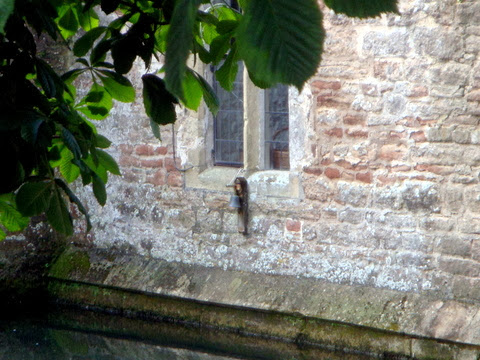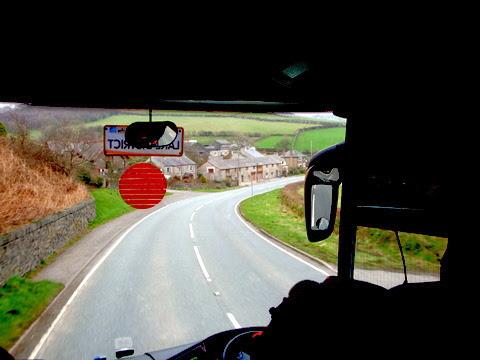The swan’s bell
A small bell, with a rope hanging
from it, hangs below the gatehouse window of the Bishop’s Palace in Wells, Somerset
Swan bell
The duck tree
In 1601 a duck flew into a tree outside the Devonshire
Arms in the tiny village
of Sheldon
Sheldon
The Drunken Duck
Formerly the Barngate Inn near to the village of Outgate Cumbria
Lowick from coach window
The humble turkey
Boynton Hall in the tiny wolds village of Boynton East Yorkshire , is the ancestral home of
the Strickland family. William
Strickland travelled to the Americas in the mid 1500’s and when he returned to
England he brought with him the humble turkey which he had discovered on his
travels in the new world. Needless to
say, he became a very rich man and in 1550 he was granted a crest for a family
coat of arms – ‘ A turkey in its proper
pride, beaked, membered, sable coated and wattled gules.’
In the village church at Boynton, Strickland family
memorials are surmounted by turkeys and indeed the lecturn is a turkey carved
in wood.
The robin’s nests
A robin, perched on a plaque at the side of the altar in
the church at Wimbourne-St-Giles in Dorset ,
recalls a series of curious events. The
plaque reads :
“ Here while the respond to the arcade of AD
1887 was building, a robin nested.
Again during the building of a new arcade
after the fire of 1908.”
Apparently the first family of robins nested near the
altar during roof repairs in 1887.
Robins were sacred birds with the blood of Christ on their breasts and
their arrival was a good omen. When the
fledglings had left the nest, the nest was put into a jar and built into the
wall with an account of the event.
Amazingly 20 years later, when the church was badly damaged by fire, a
pair of robins again nested in the same spot.
Once again the nest was built into the wall and it was then that the
details of the first nest were revealed.
Wimborne St Giles church
Arlington
Court Devon
belonged to the Chichester family for over 500
years and the house and estate was bequeathed to the National Trust by Miss
Rosalie Chichester on her death in 1949 – she had lived there for 84
years. For 46 years, Miss Chichester’s
constant companion was her pet parrot
Polly, who was allowed to fly freely in the White Drawing Room where Miss
Chichester spent much of her time. When
Polly died she was buried in the grounds where a memorial stone marks her
grave. It reads :Arlington Court Polly's grave
Scarborough
The cuckoo bush
One may wonder at the origins of The Cuckoo Bush Inn in
the village of Gotham
The cuckoo legend
Years ago the people of Marsden, a small Pennine town near
Huddersfield in West
Yorkshire , also had trouble with a cuckoo! They were aware that its arrival heralded
spring and sunshine, so they tried to prolong its stay by building a wall round it!
Unfortunately the wall wasn’t high enough – ‘ It were nobbut one course too low!’
And so the cuckoo legend was started and is now celebrated on Cuckoo
Day in Marsden at the end of April.
This is when the inhabitants of the town let their hair down with a
cuckoo walk, cuckoo quiz, cuckoo parade and a cuckoo ball.
Polly the parrot
POLLY
An Amazon parrot
Died April 24th 1919
Having lived at
For 46 years.
The Lyver Bird
The bird on the Liverpool
coat of arms is certainly a mythical bird and it is a bit of a mystery how it
got its name – the Lyver Bird. It is
said that the artist intended it to be an eagle but managed to get it quite
wrong. A closer look at the bird shows
it has something in its beak – maybe seaweed – laver being any edible
seaweed. Some say that is how the bird
and the city got its name.
The Lyver Bird
Seagulls
Seagulls are very much part of the British seaside scene
and mostly nest on nearby cliff faces.
However in recent years many of these birds have preferred to build
their nests on buildings, much to the consternation of the occupants, presenting
an ongoing environmental problem.
Kittiwake Colony
A colony of Kittiwakes
nest on bridge and building ledges on the Tyneside quay at Newcastle and Gateshead
and are now a unique attraction but also somewhat of a pest due to extensive
droppings. It is the most inland
breeding colony anywhere in the world.





















No comments:
Post a Comment